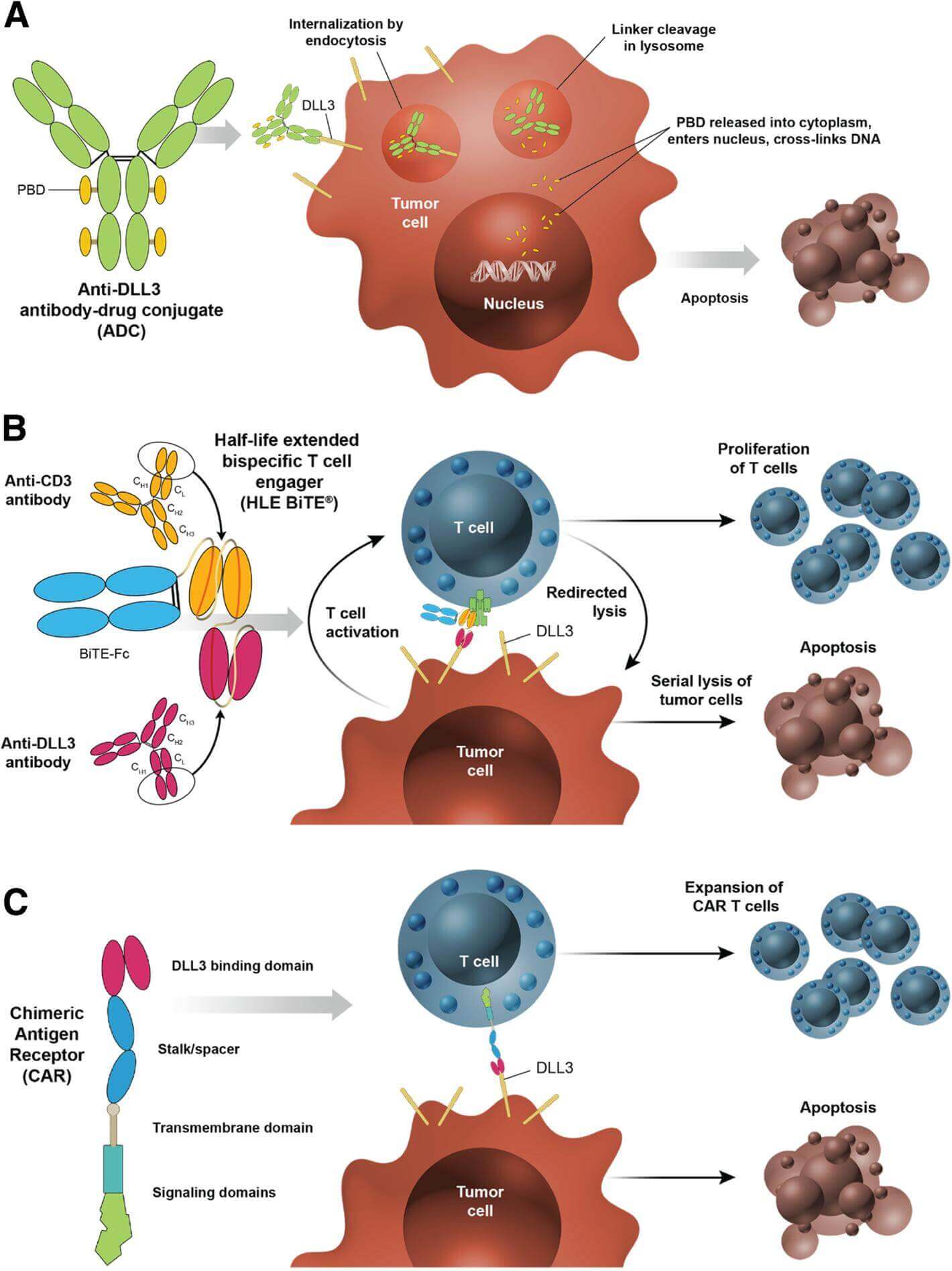
Our promise to you:
Guaranteed product quality, expert customer support.
 24x7 CUSTOMER SERVICE
24x7 CUSTOMER SERVICE
 CONTACT US TO ORDER
CONTACT US TO ORDER
DLL3 Gene Editing 
The Notch signaling pathway in mammalian cells is the basis of differentiation, proliferation and apoptotic cellular programs. Notch activation is related to the oncogenic pathogenesis of multiple malignancies such as T-cell lymphoma; breast cancer; osteogenic sarcoma; chronic lymphocytic leukemia; cervical; endometrial; lung; renal; pancreatic, head and neck; gastrointestinal and hepatocellular cancer; and medulloblastoma. However, Notch seems to be a tumor inhibitor in neuroendocrine cells and other cell lines. DLL3 inhibits the Notch pathway, and in healthy cells, is localized to intracellular membranes. Compared with healthy cells (including 80% SCLC), DLL3 is expressed on the surface of neoplastic neuroendocrine cells. Activation of the ligand leads to rapid internalization and attachment to the NOTCH1 protein, signaling the deactivation of the pathway. DLL3 can promote the proliferation, migration, and invasion of tumor cells. DLL3 selectively binds to DLL3-positive tumor cells and T cells to induce immunological synapses, which lead to tumor cell lysis and T-cell activation. DLL3 plays an important role in immune regulation.
DLL3 and Small Cell Lung Cancer
DLL3 is specifically expressed on the surface of SCLC tumor cells. DLL3 surface expression correlated with time to tumor progression in 10 SCLC and 1 large cell neuroendocrine carcinoma (LCNEC) patient-derived xenograft models. More than 80% of SCLC tumors express DLL3 mRNA and protein, and cytoplasmic and membranous staining of DLL3 was observed by IHC with a high level of homogeneity across neoplastic cells. In contrast, only a few normal cell types expressed DLL3, and expression of DLL3 was exclusively cytoplasmic. Recent studies have shown that DLL3 is also expressed in other tumor types of neuroendocrine origin, including melanoma, small cell bladder cancer, metastatic castration-resistant prostate cancer, glioblastoma multiforme, and neuroendocrine lung tumors.
The DLL3 expression profile—high, homogeneous cell surface expression in tumors, versus low, cytoplasmic expression in a subset of normal tissues—has enabled the development of therapeutics that use DLL3 to specifically target SCLC cells. These DLL3-specific agents are currently being evaluated in several ongoing clinical studies in SCLC and other neuroendocrine tumors. ADCs use an antibody against a tumor cell surface antigen to deliver chemotherapy to tumor cells and enable internalization of the compound to promote tumor cell killing. A novel DLL3-targeted ADC, SC16DL6.5, showed durable responses in SCLC and LCNEC patient-derived xenograft (PDX) preclinical models. This DLL3-ADC, now known as rovalpituzumab tesirine, is composed of a humanized DLL3-specific IgG1 monoclonal antibody, and a protease-cleavable linker and the DNA cross-linking agent pyrrolobenzodiazepine (PDB). In immunofluorescence colocalization studies, rovalpituzumab tesirine was internalized to late endosomes through DLL3-expressing cells.
 Figure 1. DLL3-targeted investigational products utilize distinct mechanisms of action. (Owen D H, et al., 2019)
Figure 1. DLL3-targeted investigational products utilize distinct mechanisms of action. (Owen D H, et al., 2019)
DLL3 Gene Editing Services
CRISPR/Cas9 PlatformCB at Creative Biogene is dedicated to offering comprehensive CRISPR/Cas9 gene editing services and products for academic research, biotech research and pharmaceutical drug discovery. With deep gene editing knowledge and extensive experience in experimental operation and data processing, we help you effectively control DLL3 genes knockout/knockin/point mutation in cells or animals via CRISPR/Cas9 technology.
| Service | Details | Alternative cell lines or animal species |
| DLL3 Gene Editing Cell Line Generation | gRNA design and synthesis Transfect the cell lines you're interested Select the high expression cells and sort monoclonal cell Validate the knockout/knockin/point mutation of DLL3 by PCR and sequencing Provide cryogenically preserved vials of stable cells and final reports | HEK239T, Hela, HepG2, U87, Ba/F3, CHO, MDA-MB-453, MDA-MB-231NIH3T3, T47D, Neuro2a, MCF7, RKO, K562, RAW264.7, etc. |
| DLL3 Gene Editing Animal Model Generation | DLL3 gene conventional knockout animals DLL3 gene conditional knockout animals DLL3 point mutation animals DLL3 knockin animals | Mouse, rat, rabbit, zebrafish, C. elegans, etc. |
Related Products at CRISPR/Cas9 PlatformCB
| CATALOG NO. | PRODUCT NAME | PRODUCT TYPE | INQUIRY |
| CDKM-0531 | B6J-Dll3em1Cflox | Knockout Mouse | Inquiry |
References
- Owen D H, et al. DLL3: an emerging target in small cell lung cancer. Journal of hematology & oncology, 2019, 12(1): 1-8.
- Lashari B H, et al. Rovalpituzumab tesirine: A novel DLL3-targeting antibody–drug conjugate. Drugs in R&D, 2018, 18(4): 255-258.
- Maimaiti A, et al. Integrated gene expression and methylation analyses identify DLL3 as a biomarker for prognosis of malignant glioma. Journal of Molecular Neuroscience, 2021, 71(8): 1622-1635.
- Tanaka K, et al. Prevalence of Delta-like protein 3 expression in patients with small cell lung cancer. Lung Cancer, 2018, 115: 116-120.
- Lehman J M, Horn L. Targeted therapy in small cell lung cancer: can DLL3 notch up a victory?. Transl. Cancer Res., 2017, 6: S453-S456.